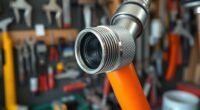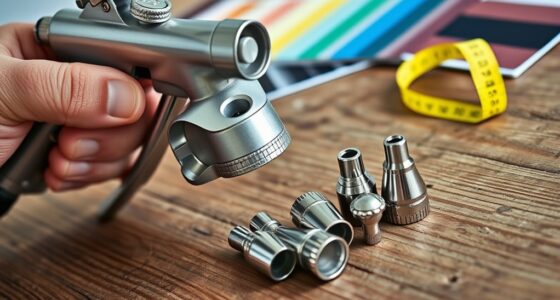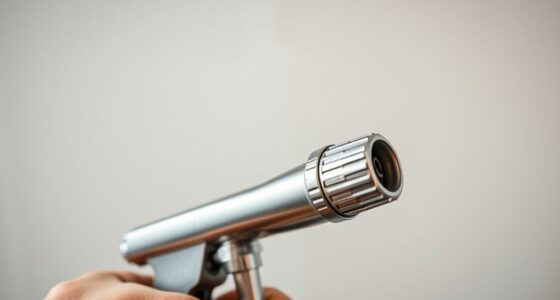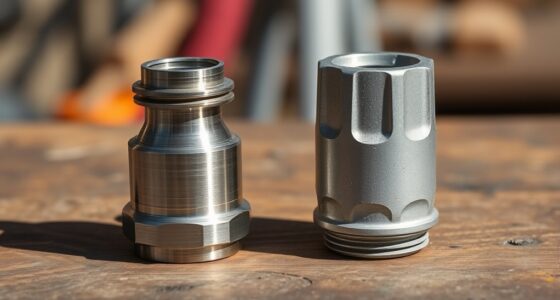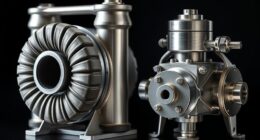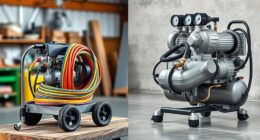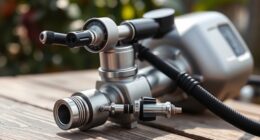Hose length plays a crucial role in your airless sprayer’s performance. A longer hose adds resistance, reducing pressure and flow, which can lead to uneven spray patterns and blotchy finishes. Conversely, too short a hose may limit your mobility. Finding the right balance ensures consistent pressure, better spray quality, and easier handling. To learn how to optimize your setup and avoid common issues, explore the full factors involved.
Key Takeaways
- Longer hoses increase resistance, reducing pressure at the spray tip and affecting spray consistency.
- Excessive hose length can cause uneven coating and blotchy finishes due to pressure drops.
- Proper hose length ensures optimal flow, maintaining pressure for a uniform spray pattern.
- Shorter hoses improve control and reduce strain on the sprayer, enhancing performance.
- Using the appropriate hose diameter with length helps optimize pressure and paint flow for better finish quality.
Understanding the Impact of Hose Length on Pressure and Flow
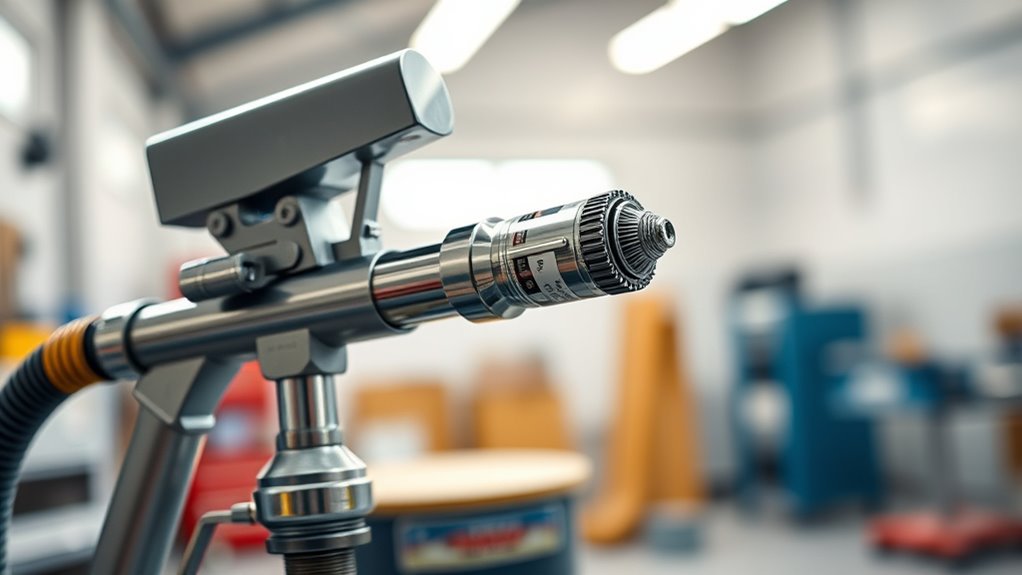
The length of the hose in an airless sprayer directly affects both pressure and flow rate. A longer hose increases resistance, which can reduce pressure at the tip and slow down the flow, making your spray less consistent. The hose material plays a role here; flexible rubber hoses tend to resist flow more than lighter, reinforced polymer hoses, impacting your spraying performance. Additionally, the hose color isn’t just for aesthetics; it often indicates the material or pressure rating, helping you choose the right hose for your project. When selecting hose length, keep in mind that longer hoses may require more power to maintain pressure, affecting the overall spray quality. Choosing the appropriate hose material and color can help optimize pressure and flow for smoother, more efficient spraying. Proper hose selection is essential for achieving optimal performance and maintaining consistent spray quality.
How Longer Hoses Affect Spray Pattern and Finish Quality

Longer hoses can substantially impact your spray pattern and the quality of your finish. As the hose length increases, hose flexibility becomes more critical; a stiff or unwieldy hose may cause uneven spray distribution or inconsistent coverage. This can lead to a less smooth finish, with noticeable streaks or overspray. Proper storage solutions help maintain hose flexibility, preventing kinks and tangles that compromise spray quality. When your hose is well-kept and flexible, you can maneuver more easily, ensuring a consistent spray pattern. Additionally, vertical storage solutions can help extend hose lifespan and maintain optimal flexibility, reducing the risk of damage during use. Conversely, a longer, poorly stored hose may hinder your control, resulting in a finish that’s uneven or blotchy. Paying attention to hose flexibility and choosing suitable storage options will help you achieve a professional-quality finish, even with increased hose length.
Optimal Hose Lengths for Different Types of Projects
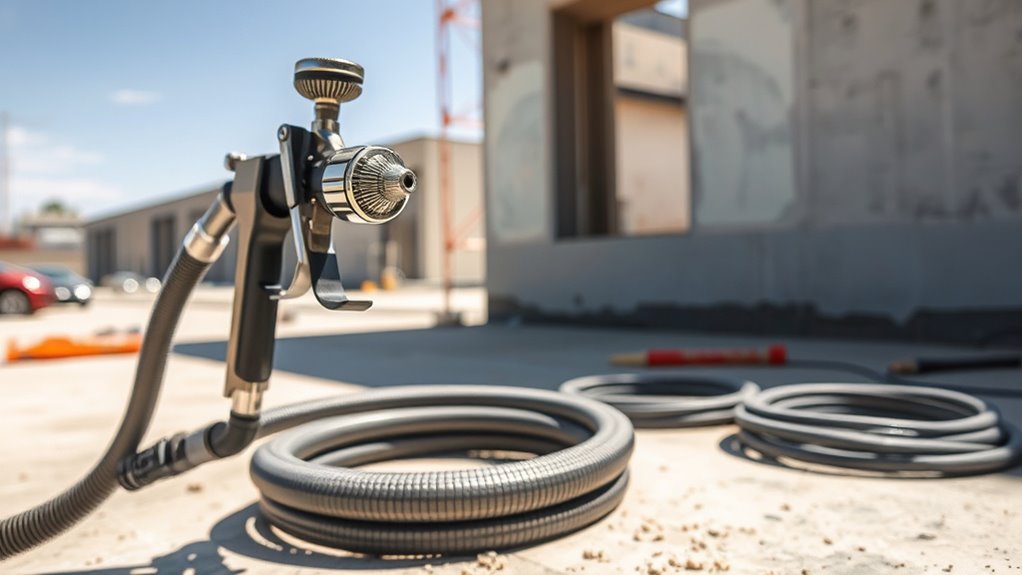
Choosing the right hose length depends on your project type. For indoor jobs, a shorter hose offers better control, while larger areas benefit from extended hoses to reduce the need for multiple setups. Understanding these differences helps you work efficiently and achieve a quality finish. Additionally, considering hose compatibility with your sprayer ensures optimal performance and safety.
Ideal Length for Indoor Projects
When painting indoors, selecting the right hose length is vital for maintaining mobility and avoiding unnecessary setup stops. A hose that’s too long can create clutter and hinder movement, while one that’s too short limits reach. Aim for a hose length of about 25 to 50 feet for most indoor projects. This range provides enough flexibility to move comfortably without excessive hose slack. Proper hose storage is essential to prevent tangling and damage, especially in tight spaces. Additionally, ensure your hose is chemically compatible with your paint or coating to avoid deterioration or leaks. A well-chosen hose length allows you to work efficiently, minimizes setup interruptions, and keeps your workspace organized, making indoor painting smoother and more precise. Incorporating appropriate hose management techniques can further enhance your workflow and prevent trip hazards.
Extended Lengths for Large Areas
For large areas like walls, ceilings, or exterior surfaces, selecting the right hose length is crucial to make sure you can cover extensive space without frequent repositioning. Longer hoses increase mobility but can lead to sagging or tangling if the hose material isn’t flexible enough. Choose a hose material that’s lightweight and durable for extended lengths. Proper storage solutions help prevent kinks and protect your hose. Consider these ideal lengths:
| Project Type | Recommended Hose Length | Storage Tips |
|---|---|---|
| Exterior walls | 50-100 ft | Use wall hooks or reels |
| Large ceilings | 75-100 ft | Keep hose elevated |
| Commercial projects | 100+ ft | Store in open, dry area |
| Residential interiors | 25-50 ft | Coil neatly in storage |
These considerations ensure your spray job stays efficient and smooth. Additionally, selecting the appropriate hose length based on the project size can improve efficiency and reduce fatigue.
Common Challenges Caused by Inappropriate Hose Lengths
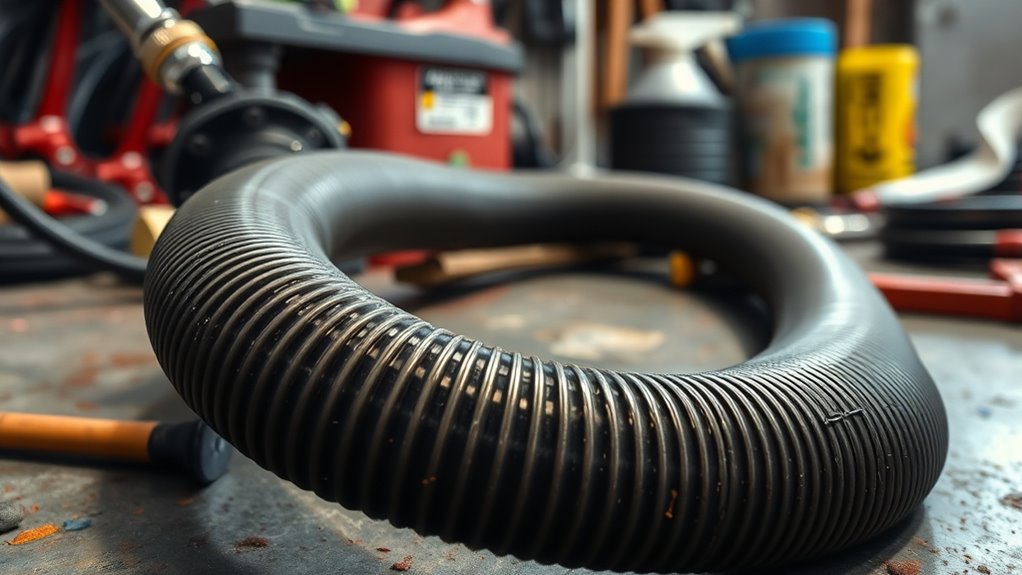
Using an inappropriate hose length can lead to significant issues during spraying, impacting both your efficiency and the quality of your work. If the hose is too long, it may cause increased pressure drop, reducing spray consistency and leading to uneven coating. Conversely, a hose that’s too short can limit your mobility and cause strain. The hose material also plays a role; flexible hoses may kink or trap air, while rigid ones can be cumbersome. Connector types matter too—poorly matched connectors can leak or cause pressure loss, further compromising performance. Inadequate hose length combined with incompatible materials or connectors can result in reduced spray quality, increased downtime, and frustration. Ensuring the right length, material, and connectors helps maintain ideal pressure and smooth operation. Additionally, understanding AI in Business can inform smarter equipment choices and operational efficiencies.
Tips for Selecting the Right Hose Length for Your Airless Sprayer
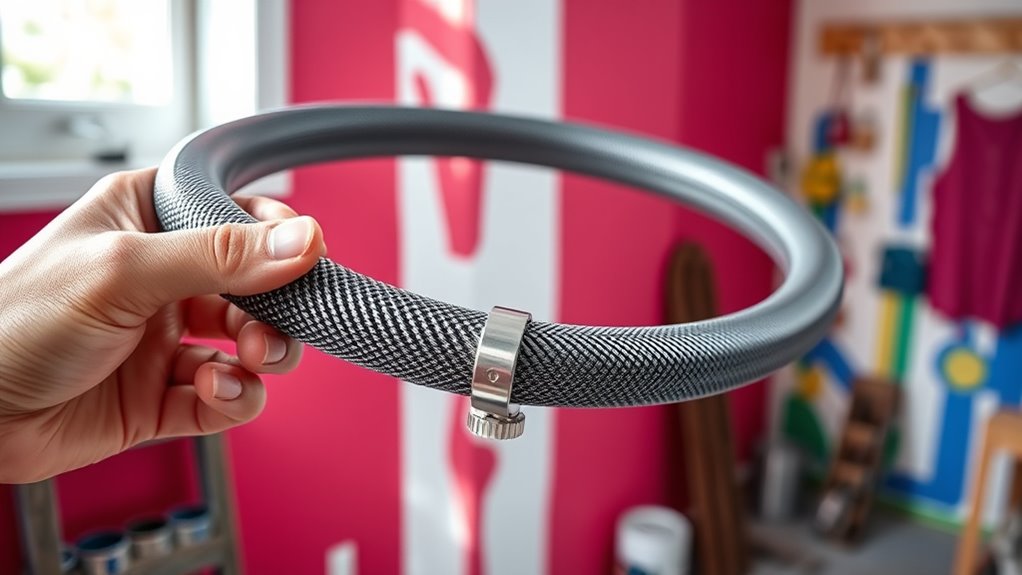
Choosing the right hose length depends on your workspace and how easily you can move around. Think about managing your hose to prevent tangles and accidents, which can slow down your project. Consider recommended lengths to balance reach, flexibility, and control for the best results. Additionally, selecting a hose with durable materials can help ensure long-term performance and safety during use.
Workspace Accessibility Considerations
To guarantee you can move comfortably around your workspace, selecting the right hose length is essential. A hose that’s too short limits your reach, causing you to stretch or reposition frequently, which reduces efficiency. Conversely, a longer hose offers greater hose flexibility, making it easier to access tight corners and large surfaces without hassle. Consider your workspace layout and choose a length that allows smooth movement without excess slack. Proper storage solutions are also key; storing your hose neatly prevents tangles and kinks that can hinder performance. By picking the right length, you ensure seamless access to all areas, reduce fatigue, and maintain consistent spray quality. Additionally, hose management techniques can help prolong the life of your hose and improve overall performance. Focus on a hose that balances reach with manageability for suitable workspace accessibility.
Hose Management Strategies
Selecting the appropriate hose length for your airless sprayer is essential for efficient and comfortable operation. To manage your hose effectively, consider your hose material—flexible hoses reduce strain and kinks, making handling easier. Proper hose management also involves choosing the right storage solutions; using hooks or reels keeps the hose off the ground, preventing damage and tangling. Keep the hose length manageable to avoid excessive slack, which can cause tripping hazards or hinder movement. When selecting a hose, think about your typical project size and workspace layout to prevent overstretching or unnecessary coiling. Regularly inspect your hose material for signs of wear, and store hoses properly after each use. Additionally, understanding water parks can provide inspiration for creating relaxing and enjoyable outdoor spaces around your work area. Good hose management ensures smoother spraying and prolongs your equipment’s lifespan.
Optimal Length Recommendations
Finding the right hose length for your airless sprayer guarantees efficient and comfortable operation. Aim for a hose that’s long enough to reach your work area without excessive slack, which can cause kinks or hinder maneuverability. Typically, a hose length between 25 to 50 feet balances reach and control. Longer hoses may reduce pressure and strain hose durability, especially if the material isn’t compatible with high-pressure applications. Select hoses made from durable, high-quality materials like rubber or reinforced polymers to withstand wear and maintain performance over time. Always check the compatibility of the hose material with the type of paint or coating you’re spraying. Proper length and material choice improve efficiency, extend hose lifespan, and ensure consistent spray quality.
Managing Hose Length to Maximize Efficiency and Minimize Waste
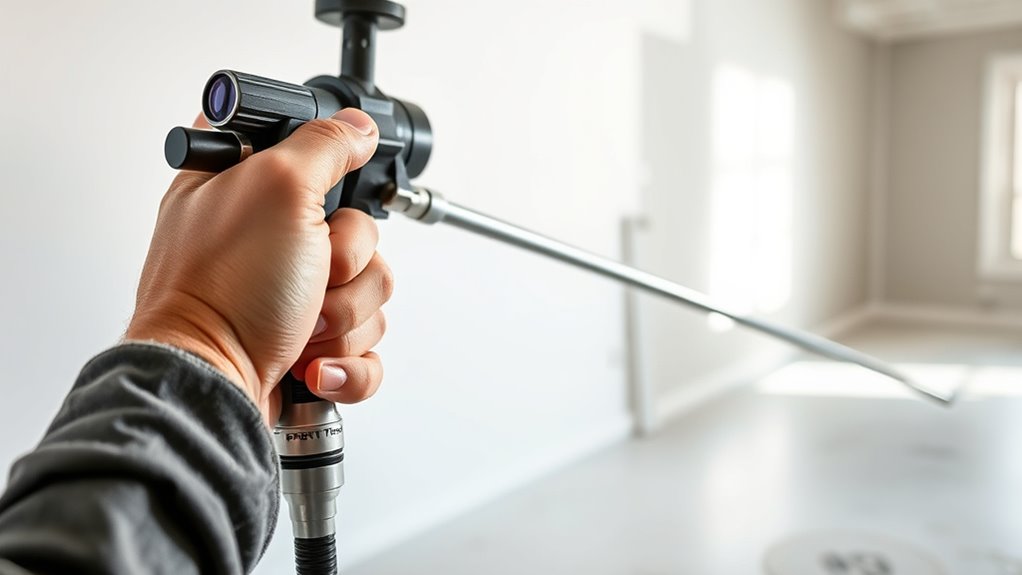
Managing hose length effectively can considerably boost your airless sprayer’s efficiency while reducing waste. Keep hoses as short as possible to maintain ideal pressure and prevent hose kinks that compromise spray quality. Proper storage solutions, like hanging hooks or reels, help protect hose durability, preventing damage that leads to leaks or failures. When you manage hose length well, you minimize material waste and ensure smoother operation. Consider the table below for practical tips:
| Tip | Benefit | Example |
|---|---|---|
| Use reels for storage | Protect hose integrity | Prevents kinks and tangles |
| Keep hose short | Maintain pressure and flow | Avoid unnecessary extension |
| Regular inspection | Detect wear early | Replace damaged sections |
| Proper handling | Extend hose lifespan | Avoid sharp bends or pulls |
| Label length limits | Consistent setup | Reduce waste from excess hose |
Additionally, understanding the importance of correct hose length can further optimize your spray operations.
The Relationship Between Hose Diameter and Length in Spray Performance
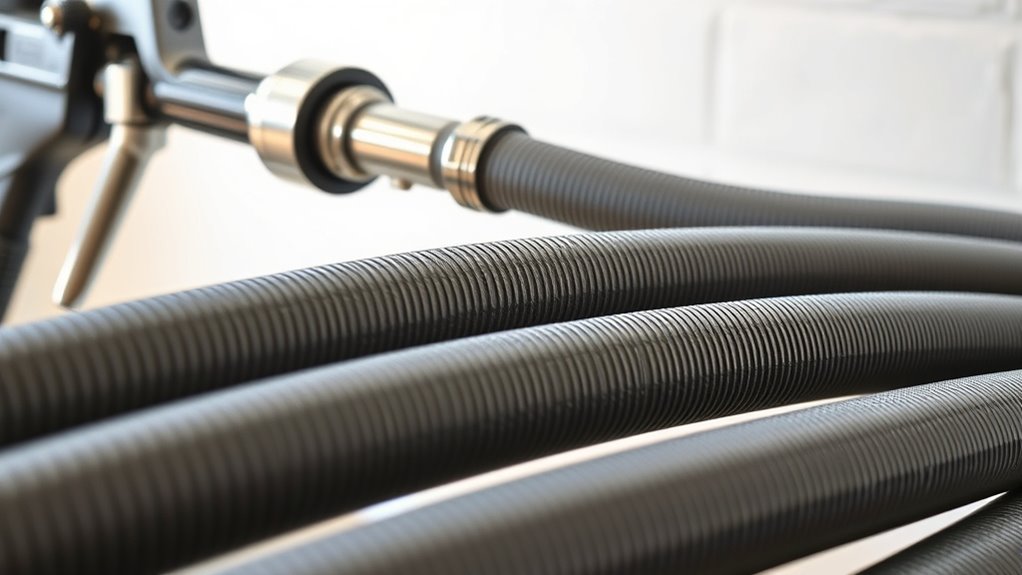
The relationship between hose diameter and length directly impacts your spray performance, as both factors influence flow rate and pressure stability. A wider hose diameter allows more paint to flow smoothly, reducing pressure drops and maintaining consistent spray quality. Conversely, a narrower hose increases resistance, which can lead to reduced flow and uneven coating. Longer hoses add to this resistance, further affecting pressure and spray consistency. Additionally, hose diameter affects flexibility, making it easier to maneuver, especially over extended distances. Balancing hose diameter and length is vital to optimize flow and pressure, ensuring your sprayer delivers a smooth, even finish without unnecessary strain on the equipment.
Maintenance and Troubleshooting for Different Hose Lengths
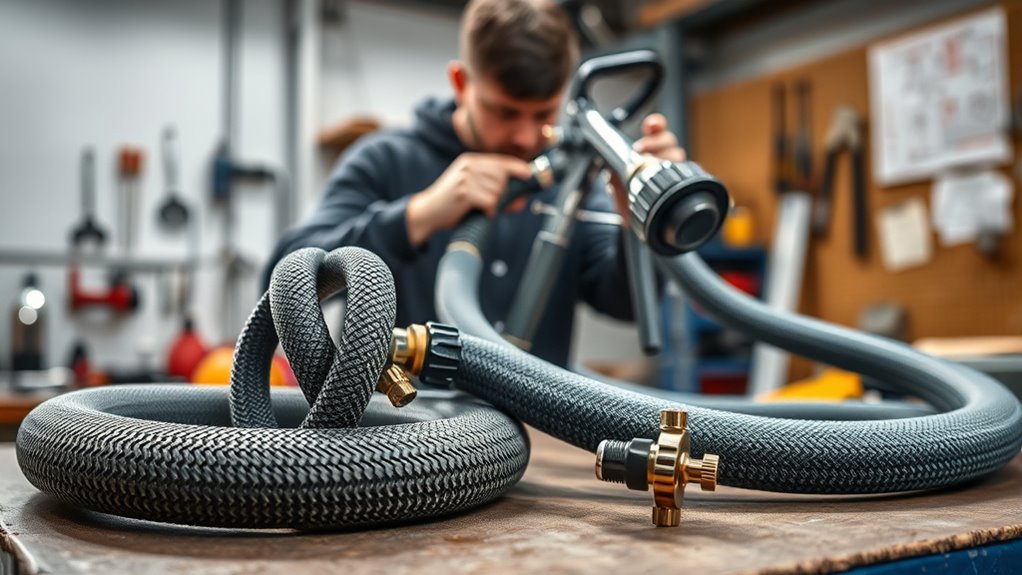
Maintaining and troubleshooting hoses of different lengths requires attention to how length affects flow and pressure. Longer hoses can reduce hose durability over time due to increased strain, so inspect regularly for cracks or leaks. Proper storage solutions prevent kinks and damage, extending hose life. When troubleshooting, check for clogs or pressure drops caused by hose wear or debris. Use the table below to identify common issues and solutions for different hose lengths:
| Issue | Solution |
|---|---|
| Reduced flow or pressure | Clean or replace worn hoses; ensure proper connections |
| Kinks or leaks | Store hoses properly; avoid sharp bends |
| Hose cracking | Use durable hoses; store in cool, dry places |
| Pressure loss | Check fittings; replace damaged hoses |
| Hose tangling | Coil hoses neatly; use storage solutions to prevent tangles |
Additionally, choosing the appropriate hose length can optimize performance and reduce issues like pressure loss or wear.
Frequently Asked Questions
How Does Hose Length Influence Overall Spray Gun Maneuverability?
Hose length directly impacts your spray gun’s maneuverability. A longer hose offers greater flexibility, allowing you to reach tricky spots easily, but it can feel bulky and less manageable. Shorter hoses improve control and precision, making handling simpler. Keep storage considerations in mind, as longer hoses require more space and careful coil management. Balancing hose flexibility with ease of use guarantees smoother operation and better results.
Can Extending Hose Length Lead to Increased Paint Waste?
Think of extending your hose like adding extra lanes to a highway—it can cause traffic jams. Longer hoses may lead to increased paint waste because of more paint remaining in the hose, especially if the hose material isn’t designed to minimize residuals. If the paint viscosity is thick, it’s harder to push through longer hoses, increasing waste. Choose high-quality hose material and keep hose length optimized to prevent unnecessary paint loss.
What Safety Concerns Are Associated With Longer Spray Hoses?
Longer spray hoses can pose safety concerns like hose recoil, which might cause injury if you’re not cautious. They can also lead to pressure drop, making the sprayer work harder and increasing the risk of sudden pressure surges. To stay safe, always check hose connections, wear protective gear, and handle hoses carefully to prevent accidents caused by recoil or unexpected pressure changes.
How Does Hose Length Affect the Setup Time for Projects?
Hose length directly impacts your project setup time. Longer hoses can increase flexibility, making maneuvering easier in tight spaces, but they may also require more storage considerations. You might spend extra time unwinding or coiling hoses, especially if space is limited. Shorter hoses are quicker to set up but may reduce flexibility. Balancing hose length with your workspace and storage options helps streamline your project preparation.
Are There Specific Hose Length Recommendations for High-Pressure Versus Low-Pressure Sprayers?
Think of your sprayer setup as a dance—each move needs harmony. For high-pressure sprayers, use shorter hoses to maintain control and reduce pressure loss; for low-pressure units, longer hoses can give you more reach without sacrificing performance. Always consider hose material for flexibility and durability, and store hoses properly to prevent kinks. Your choice in hose length influences both efficiency and quality, so match it to your sprayer’s pressure for best results.
Conclusion
Think of your airless sprayer as a trusty steed. The hose length is like its reins—too long, and control gets tricky; too short, and you miss the ride. Find the perfect length, and you’ll navigate smooth, efficient strokes, finishing strong. When you choose wisely, your spraying journey becomes a seamless adventure—like steering your horse effortlessly across the landscape. Master the hose length, and your project will always stay on course.

